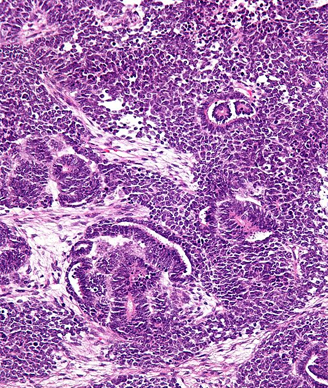Radiation Therapy for Childhood Cancer May Up Breast Cancer Risk
Children treated for Wilms tumor, a rare kidney cancer, with chest radiation may be at a higher risk for developing breast cancer in adulthood.
Low magnification micrograph of a Wilms tumor; copyright 2011 Nephron.

Children treated for Wilms tumor, a rare kidney cancer, with chest radiation may be at a higher risk for developing breast cancer in adulthood. A study of 2,492 young women who were diagnosed with Wilms tumor and followed from age 15 showed that over 20% developed breast cancer by age 40. Compared with a 0.3% cumulative risk among Wilms tumor survivors who received no radiation therapy, those who had chest radiation had a 14.8% risk. The results of this study were published in Cancer.
The study authors suggested that breast cancer screening guidelines should be reassessed to prompt early and more thorough screening to facilitate early diagnosis for Wilms tumor survivors. Current guidelines for childhood cancer survivors from the Children’s Oncology Group recommend mammograms and breast MRI screening only for those survivors who received 20 Gy or more of radiation therapy to the chest. But, children with a Wilms tumor that has spread to the lungs receive a lower dose of radiation to the chest, generally 12 to 14 Gy. The guidelines also suggest screening should start at age 25 or 8 years after treatment ends for women who are childhood cancer survivors.
“This would exclude a large majority of patients who had received whole chest radiation for Wilms tumor,” said Norman Breslow, PhD, of the University of Washington and the Fred Hutchinson Cancer Research Center in Seattle, in a statement. “Our results suggest that the risk of early breast cancer among Wilms tumor survivors is sufficiently high that early screening might be considered an option for them.”
The Childhood Cancer Survivor Study, published in 2004, estimated that childhood cancer survivors who were treated with chest radiation therapy were almost 25 times as likely to be diagnosed with breast cancer as adults compared with the general population in the United States, but that data came mainly from those who were treated for Hodgkin lymphoma and who were exposed to a wide range of radiation doses.
The median age of participants in this study was 27.3 years and the median age of first breast cancer diagnosis was 34.3 years (range, 15.5 to 48.4 years). The median time from Wilms tumor diagnosis to a first breast cancer diagnosis was 27.1 years.
Breslow and colleagues also found that those women who had abdominal radiation as children had a 3.1% cumulative risk of developing breast cancer by age 40.
Women who received chest, abdominal, and no radiation for Wilms tumor treatment had 27.6, 6, and 2.2 times the rates of breast cancer, respectively, compared with women in the US general population.
In an accompanying editorial, Jennifer Dean, MD, and Jeffrey Dome, MD, PhD, of the Children’s National Health System in Washington, DC, highlighted the recent research that showed that less than half of childhood cancer survivors who are considered high risk for breast cancer actually abide by guidelines and receive screening starting at age 25. They suggested that educating both survivors and their healthcare providers is necessary to increase screening rates.